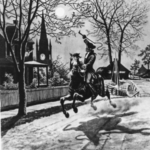The heart of the British North American possessions up until America’s independence was the mid-Atlantic colonies, including New York and Pennsylvania. The reasons for the preeminence of the mid-Atlantic were abundant. Unlike the New England and southern colonies, the economy was not imbalanced and depended equally on commerce, agriculture, and overseas trade. This was facilitated by the fact that Boston, New York City, and Philadelphia were far more convenient urban centers than those in the other British American regions, providing centralized locations for Crown functions and colonial trade. The central location of these cities was not by accident, but rather by an incident of geography, where navigable waters and developmentally friendly sea ports facilitated economic success. Finally, the social order of the mid-Atlantic was for the most part balanced, not as reliant on religion and slavery as social values that controlled government functions.
The development of New York and Pennsylvania as British colonies took two different trajectories all together. New York, originally the Dutch settlement of New Amsterdam, was taken by the British in 1664. Most of the colony, however, remained rural farmland with the exception of New York City, which became a burgeoning urban center for trade and government. Pennsylvania, on the other hand, epitomized the Puritan tradition that had been established early on in British American settlement. William Penn, who had been persecuted in England as a member of the more radical Pilgrim sect, was able to extract a land grant in 1681 to establish settlement in modern day Pennsylvania. Penn’s settlers, mostly of the Quaker sect of Puritanism, were pacifists and refused to pay the taxes of the Anglican Church. Unlike many other British settlements, the Quakers were accepting of all faiths in their settlement and were friendly to the native tribes within their borders. Much like New York, Pennsylvania’s urban centers remained concentrated while the sprawling lands of Pennsylvania Quaker country were similar to the western parts of the New York colony.
The British exhibited their quick study of imperial management by the strength of their colonial governments while maintaining a steady stream of revenue from the colonies’ raw materials and finished goods. All of the British colonies had a standard government structure, including a royal governor, a governor’s council, and a colonial legislatures, with governing codes that regularly demonstrated the British sophistication for colonial rulership. However, even as the strength of the colonies and the profitability began to skyrocket, the British were beginning to see daily tensions within their system. Overly bureaucratic royal officers were often times at odds with colonial leaders over the best way to manage local concerns, such as property ownership and taxation. The British felt that the colonists were already getting more power than they rightfully deserved, but wanted to maintain a certain balance between chaos and dictatorship. The colonists, who were the ones bringing in the profits for the British Crown, felt that they deserved increased political standing while maintaining their allegiance to the British Empire. These tensions would erupt quickly even within the stronghold of the mid-Atlantic and within a few decades, the subservient American colonists would engage in the greatest democratic experiment in world history to that point (and some would argue, to any point in American history).





